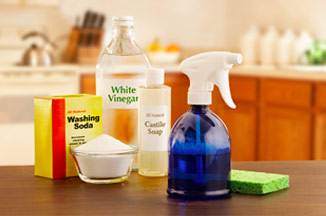Cleaning the bathroom is probably one of the many chores on your “to do” list. In an ideal word the bathroom would be thoroughly cleaned every single day, but if you are permanently chasing your tail, it is a once-per-week task. Yes, Saturday mornings are a time to dig out some rubber gloves and a bottle of bleach before knuckling down to scrub the bath and toilet. But how can you ensure your bathroom is spotlessly clean if you have run out of big brand name cleaning sprays and solutions? Brand name cleaning products are expensive and not especially good for the environment. Products containing harsh chemicals are also not recommended to us on your designer towel radiators. If the advertisements are to be believed, your bathroom will be a festering cesspit of germs if you don’t blitz it with a few brand name sprays and solutions. However, you don’t need any brand name cleaners to maintain a hygienic and sparkling clean bathroom – there are lots of simple household ingredients you can use instead. |
|
White Vinegar
White vinegar is a fantastic all-purpose cleaning solution. You can use it anywhere, even radiators and skirting boards, but it is especially good on glass and ceramic tiles because will remove water marks and soap scum effortlessly. Dilute vinegar with water in a 50:50 solution and use a spray bottle to apply the solution to glass and tiles. Diluted vinegar is great for cleaning floors and neat vinegar can be used to clean toilet bowls and sinks.
Baking Soda
Baking Soda is another handy store cupboard ingredient that doubles as a household cleaner. Its abrasive qualities make it perfect as a scrubbing agent on grimy sinks and other hard surfaces. It can also be used to absorb nasty odours, so sprinkle some on the hinges of the toilet seat or around the base of the toilet if it gets a bit whiffy and finish off with a solution of bleach.
Clear Blocked Sinks and Baths
If your sink or bath drain is slow to empty because of a build up of soap scum, instead of spending money on expensive drain cleaning agents, pour some baking soda down the plug hole and add a cup of vinegar. The resultant volcano of white foam will clear the blockage and refresh your drains, plus it will keep the kids entertained and ignite their interest in science.
Lemons
Lemons are a lot more than a great accompaniment to a nice gin and tonic. If you have a lemon handy you can put it to good use in the bathroom for it is an excellent natural bleaching agent. Lemon juice is very efficient at removing soap scum and hard watermarks in bathrooms. Lemon juice is also very useful if you have brass plated taps; unlike other cleaning products, lemon juice won’t damage the finish. If you need a more abrasive cleaner, use a cut lemon in conjunction with some baking soda.
Cleaning Floors and Tile Grout
Bathroom floors can be freshened up with solutions of vinegar and water. For tougher stains, sprinkle baking soda over the floor and follow it up with a dilute solution of bleach. Baking soda can also be used as a very effective cleaner for grubby grout between tiles. Mix some baking soda into a thick paste and apply to the affected areas.
With a bottle of white vinegar, some baking soda and a bit of elbow grease, your bathroom will be soon be looking as good as new. You do need to be careful, however, because lemons in particular can bleach surfaces. Always test your cleaning agent in an inconspicuous area if you are trying it out for the first time. That way you won’t end up with marks you can’t get rid of.



